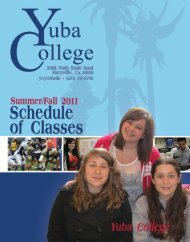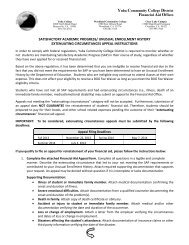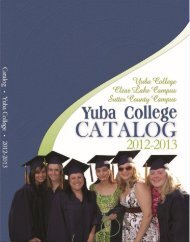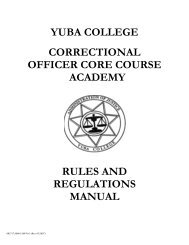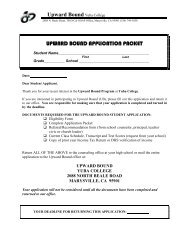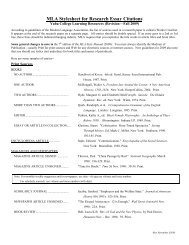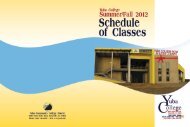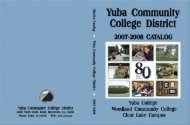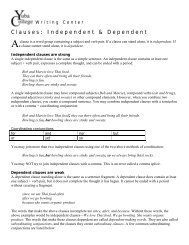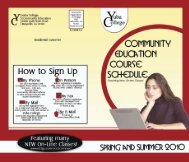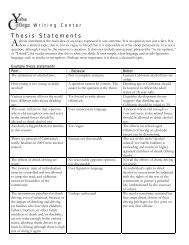Writing & Language Development Center Editing and Proofreading ...
Writing & Language Development Center Editing and Proofreading ...
Writing & Language Development Center Editing and Proofreading ...
Create successful ePaper yourself
Turn your PDF publications into a flip-book with our unique Google optimized e-Paper software.
To catch spelling or word choice errors, read each word individually from the end of each line to thebeginning. Computer spell checkers won't catch sound-alikes such as they're, their, <strong>and</strong> there, or errors suchas typing he for the. (Spell checkers are interactive. You have to choose the right word each time it stops.There’s no getting around it—you have to learn the difference between were <strong>and</strong> where. A grammarh<strong>and</strong>book or dictionary can help.)If you confuse plurals <strong>and</strong> possessives, skim looking only for words that end in s. If a word ends in sbecause it is plural, there should be no apostrophe: If the word indicates possession or is a contraction oftwo words, it needs an apostrophe. Its (the radio station is holding its fundraiser) is analogous to his orhers—no apostrophe.If you tend to make errors in subject-verb agreement, go through one sentence at a time <strong>and</strong> identify thesimple subject <strong>and</strong> main verb in each. Do the subjects <strong>and</strong> verbs go together? You can’t write, “Expertssays” or “Everybody know.”For pronoun problems, skim line by line <strong>and</strong> stop at each pronoun. Find the noun that the pronoun replaces.If you can't find it within the sentence, or at most within a sentence or two preceding, replace the pronounwith a noun. If you find the noun the pronoun refers to, but there are other nouns nearby <strong>and</strong> it might beunclear (not to you, but to a reader) which you’re talking about, replace the pronoun with a noun. Be sureevery noun agrees in number <strong>and</strong> person with its corresponding pronoun. Look especially for they, their,<strong>and</strong> them—they are plural pronouns <strong>and</strong> must refer to plural nouns. Anyone, everyone, <strong>and</strong> everybody aresingular. You can’t write, “Everybody has their books.”Fragment errors are sometimes heard better than seen. Read your paper aloud. Stop at every period <strong>and</strong> takea breath; can your ear find the fragments? Pay special attention to sentences that begin with subordinatingwords, such as because, if, or when. Watch for phrases like for example or such as or phrases starting with –ing adjectives (participles). Decide if a fragment might be just a piece of the previous or next sentence thatmistakenly got separated by a period. If so, connect it to the independent clause. Otherwise, add the missingsubject or verb or remove the subordinating conjunction.Run-on sentences are not merely long sentences; run-ons are punctuated wrongly. In particular, a solitarycomma is not allowed to join two independent clauses. If you tend to create these comma splices, start withthe last sentence of your paper <strong>and</strong> work your way back to the beginning, stopping at every comma. Is therean independent clause on both sides of the comma? If there is, the comma must be accompanied by acoordinating conjunction or replaced by a semicolon or a period.An omitted comma can result in another kind of run-on. To find omitted comma errors, skim for theconjunctions <strong>and</strong>, but, for, or, nor, so, <strong>and</strong> yet. See whether there is a complete sentence on each side of theconjunction. If there is, place a comma before the conjunction.To find introductory comma errors, read the first two or three words of each sentence. Look for subordinateconjunctions such as because or when; transition words such as nevertheless or however; participial phrasessuch as serving four years in the Navy; or prepositional phrases such as in contrast or about two years ago.Place a comma at the end of the introductory word, phrase or clause, <strong>and</strong> before the independent clause.Awkwardness results from parallel structure errors. Find these by skimming for key words that signalparallel structures: <strong>and</strong>, or, not only...but also, either...or, both...<strong>and</strong>…. Make sure that the items connectedby these words are in the same grammatical form: golf, basketball, <strong>and</strong> soccer is parallel; golf, basketball,<strong>and</strong> to play soccer is not.



